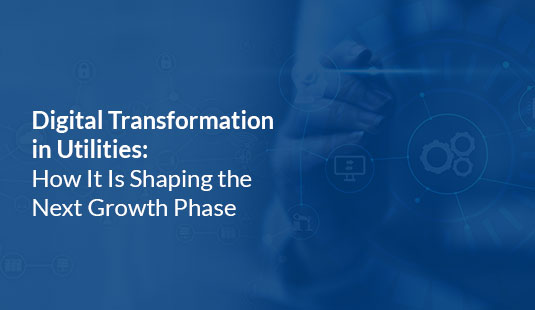How Generative AI in Utility is Transforming Billing and Customer Service
In the article, Gen AI is a subset of AI that focuses on creating content like customized billing and personalized communication, while AI broadly enhances efficiency and accuracy in utilities through automation and optimization.
The utility sector is witnessing a paradigm shift, with rich digital technologies driving greater process efficiencies. And AI is not far behind. Advanced AI systems empower utility players to reinvent their billing and customer service approaches, enhancing efficiency, accuracy, and stakeholder satisfaction. Generative AI in utilities, including natural language processing, automated content generation, and predictive analytics, in particular, are paving the way for a smarter, more responsive utility experience by automating complex billing processes and providing personalized customer support.
Applying generative AI (Gen AI) to utilities offers the C-suite an unparalleled opportunity to leverage massive data sets and gain actionable insights for strategic decision-making. It is no surprise that the Gen AI in utility market size is expected to be worth a whopping $8676 million by 2032, up from $534 million in 2022.
Many utility companies worldwide are moving away from their traditionally cautious approach to adopting Gen AI in a big way. A report by Capgemini Research Institute finds that 95% of utilities and energy companies have already scoped Gen AI, and about 33% are piloting the technology through algorithms capable of producing text, images, computer code, and more. The survey also suggests that about 40% of utility and energy companies have set up dedicated teams and budgets in place for various Gen AI initiatives.
Starting with the Basics: Streamlining Utility Billing with AI
By automating repetitive tasks, optimizing resource distribution, balancing supply and demand, and improving grid stability, Gen AI is instrumental in empowering utility companies to streamline processes. Utility billing automation can generate customized billing statements tailored to individual customer usage patterns and even flag potential billing errors before they reach the customer. Additionally, by analyzing data faster and suggesting corrective actions, Gen AI can help automate the resolution of billing discrepancies. For instance, if an anomaly is detected, the system can automatically adjust the bill or notify the customer with an explanation. Some more ways that AI-driven billing solutions are optimizing the utility sector include:

Real-time Billing Insights
Gen AI provides real-time energy usage updates to help customers control their consumption patterns and costs.

Dynamic Pricing Models
AI makes implementing dynamic pricing models and adjusting rates based on real-time demand and supply conditions easier.

Fraud Detection
AI can detect unusual patterns or anomalies in billing data that may indicate fraudulent activity.
Focusing on the Long Term: Elevating Utility Customer Engagement
The modern utility customer wants enhanced services in the form of energy savings and real-time usage insights. In this, Gen AI plays a critical role by offering proactive advice on how to optimize energy usage during off-peak hours. Given the hyper-competitive utility landscape, such differentiating measures are crucial in increasing customer satisfaction and loyalty by enabling utility players to connect more efficiently with customers, promote energy conservation, and address individual preferences.

Superior 24/7 Customer Support
AI-powered chatbots are vital in handling simple billing inquiries, providing explanations, and assisting with payment processing.

Personalized Communication
With detailed insights into customer preferences, automated systems can send tailored messages and updates, enhancing communication relevance and engagement. Besides, it also helps offer customized advice and solutions, improving customer support effectiveness.

Enhanced Customer Satisfaction
Easily available and personalized responses and solutions to their queries ensure that your customers have a higher satisfaction rate, richer engagements, and a better overall experience.
Many leading utilities are already racing ahead in their Gen AI journey. Take UK-based Octopus Energy, for instance. The company is using Gen AI to respond to customer emails and is registering a remarkable customer satisfaction (CSAT) rate of 80%, surpassing the previous 65% CSAT score achieved by its trained workforce. In another example of a generative AI case study, Ontario Power Generation (OPG), in partnership with Microsoft, developed its own version of ChatGPT called ChatOPG. The tool is actively used to provide information, answer questions, and act as a personal assistant at work, enhancing workforce productivity and safety.
KPMG finds that AI systems help reduce equipment downtime significantly, extending their lifespan, cutting expenses by up to 25%, and improving efficiency by 20%. For example, Chicago-based electric utility Exelon uses NVIDIA tools for AI training in drone inspections, enhancing grid defect detection to develop realistic, labeled examples for more efficient real-time assessments. Such measures eventually boost equipment maintenance, reduce their carbon footprint, and improve reliability.
Challenges and Opportunities in Gen AI Implementation
Research finds that Gen AI’s dependence on high-quality data to train and craft accurate models and data sets is a leading challenge in implementing successful Gen AI strategies. Utility sector data is typically scattered, incomplete, or of low quality, making robust data collection, integration, and management processes necessary to generate high-quality insights.
Besides, the strict regulations around data sharing could impede generative AI in utilities, making it necessary to negotiate these regulatory hurdles while safeguarding sensitive operational and customer information. Moreover, given the conventionally obsolete infrastructure most utilities have, integrating Gen AI into various systems is a plausible challenge that can lead to issues of interoperability, data compatibility, and timelines.
Deploying and maintaining Gen AI solutions requires the right skill set, a workforce equipped with AI and data analytics capabilities, and knowledge of utility operations. That said, the lack of skilled AI professionals within utilities could hamper the effective implementation and use of Gen AI in utilities.
Gen AI offers many promises for the utility industry. The right approach to its implementation can significantly advance and address data quality issues, regulatory hurdles, and integration complexities. There is no doubt that with continued innovation and workforce development, Gen AI can unleash the potential to revolutionize operations across the sector, drive never-before-seen efficiencies, and substantially elevate customer experiences. We still have to wait and see which companies will emerge as the winners.




